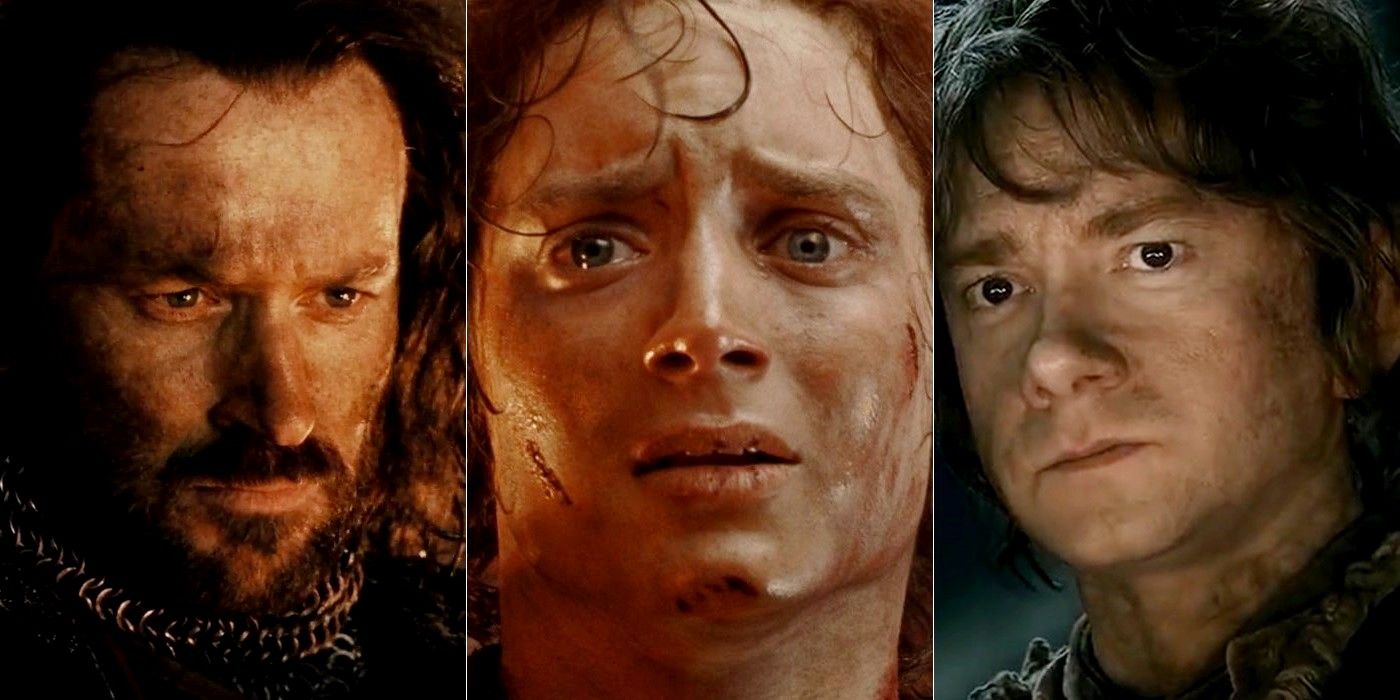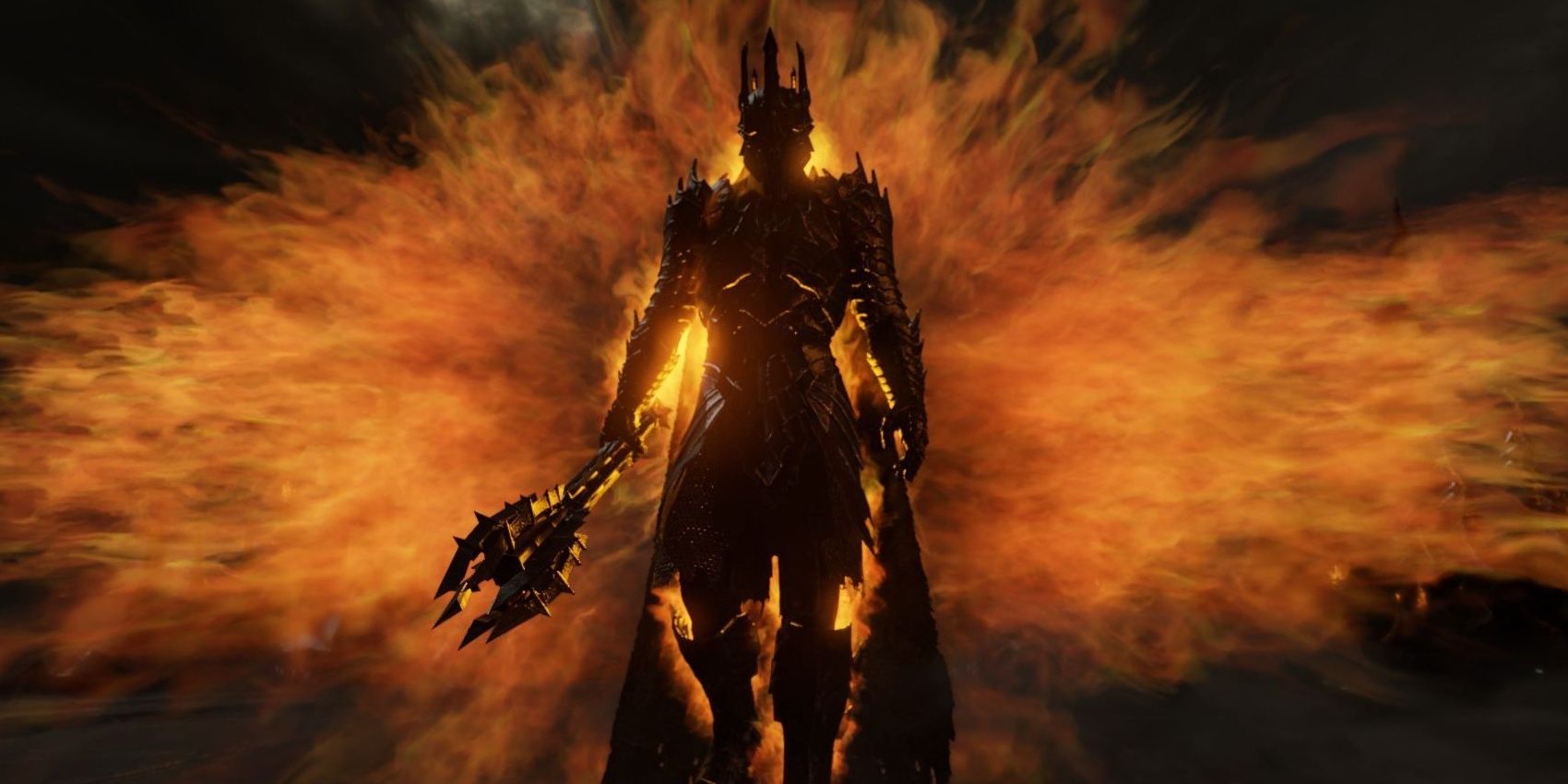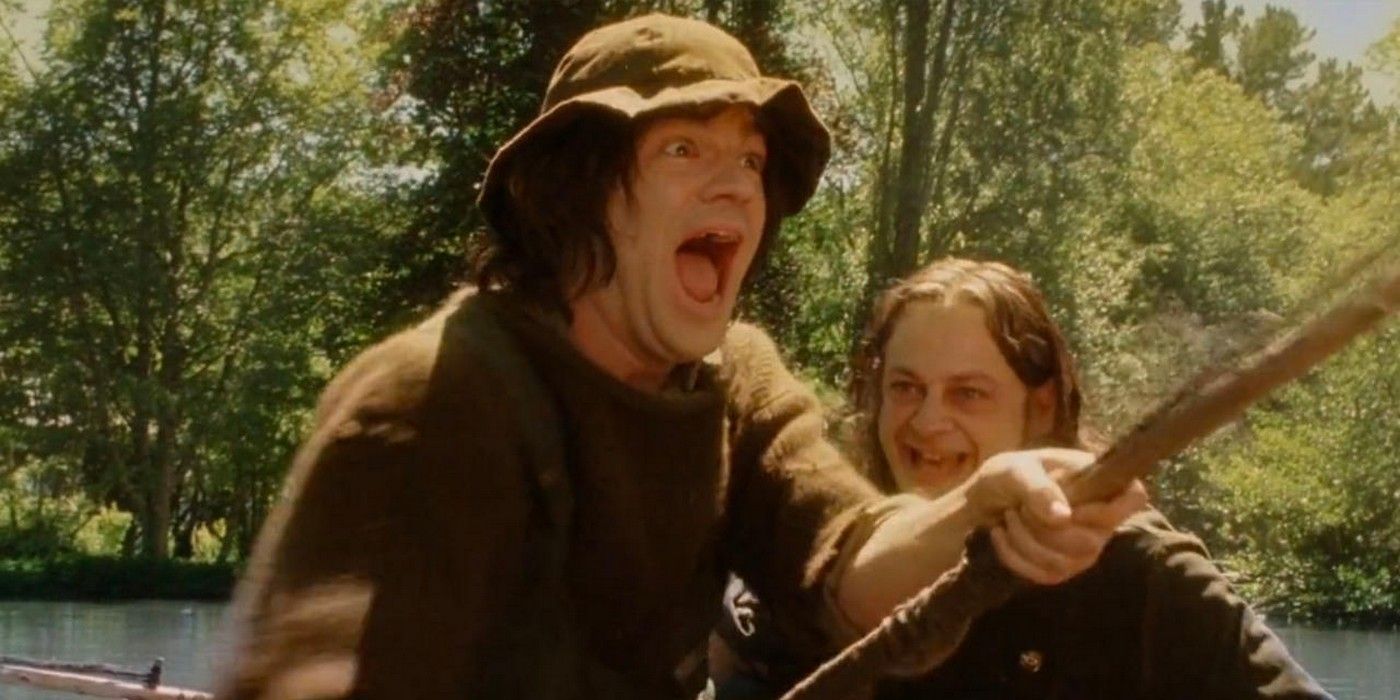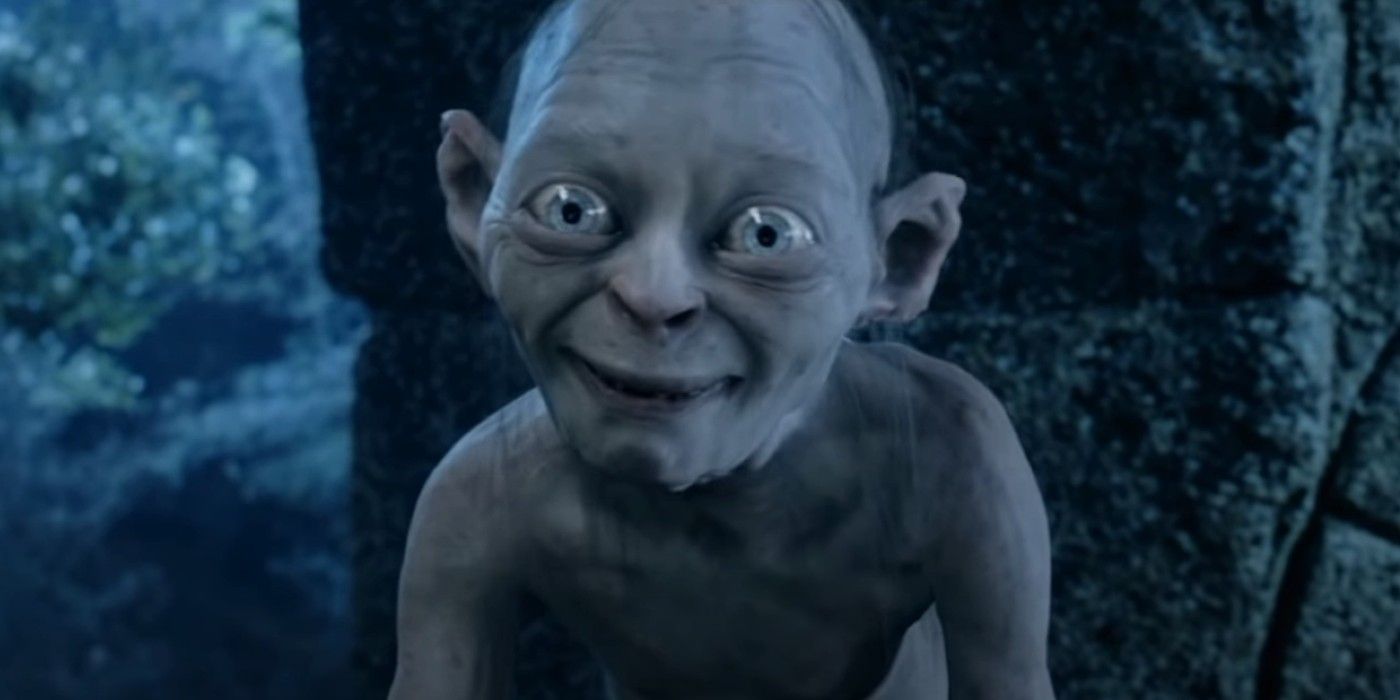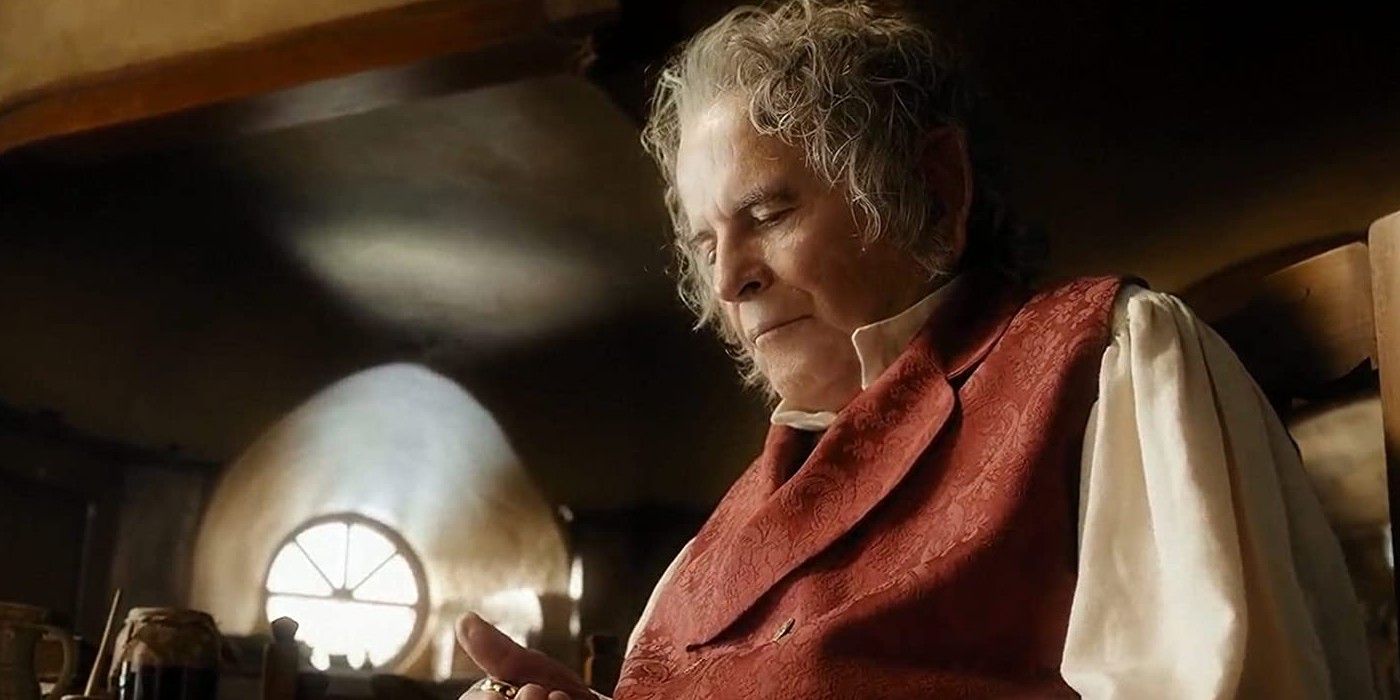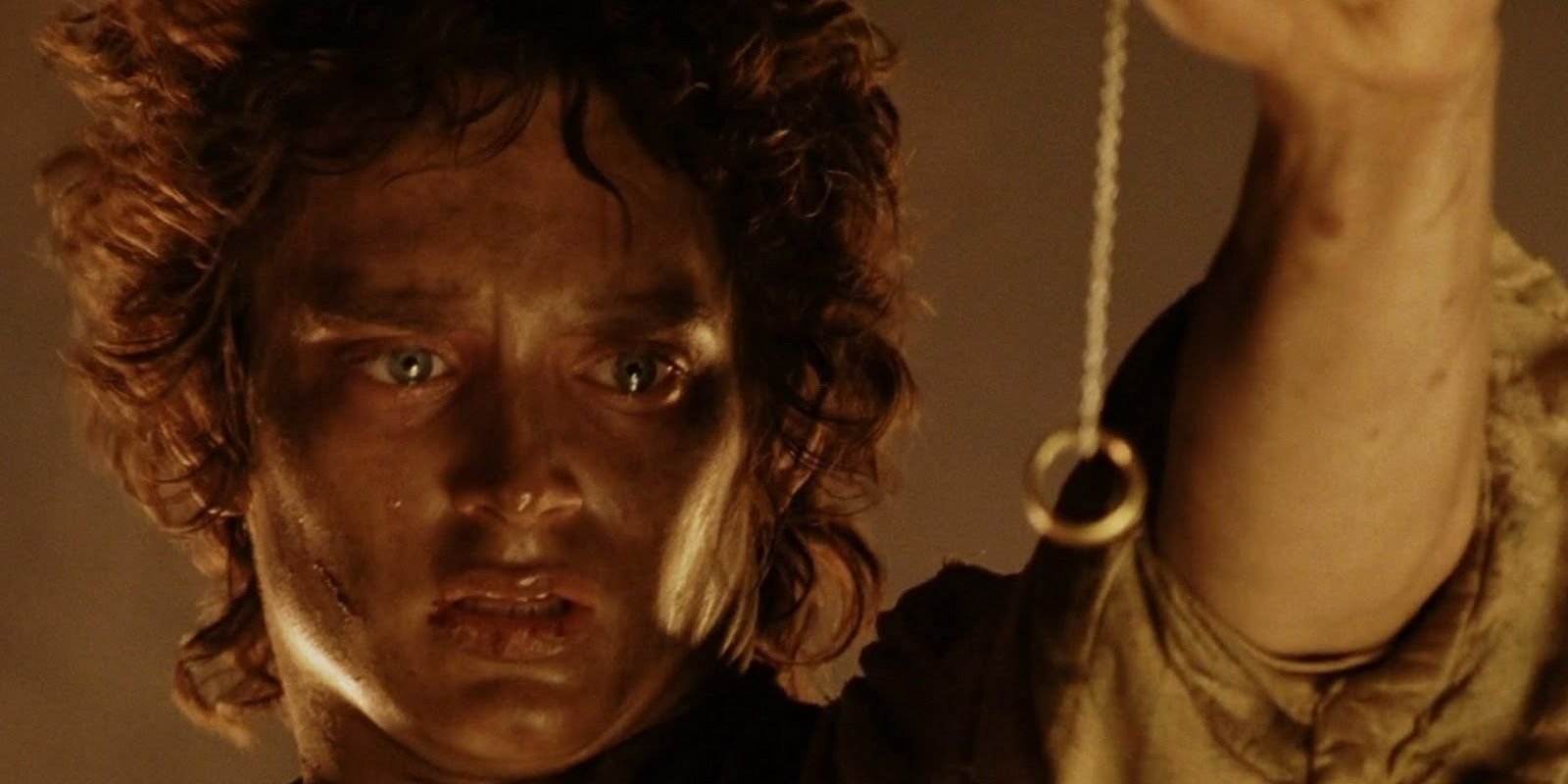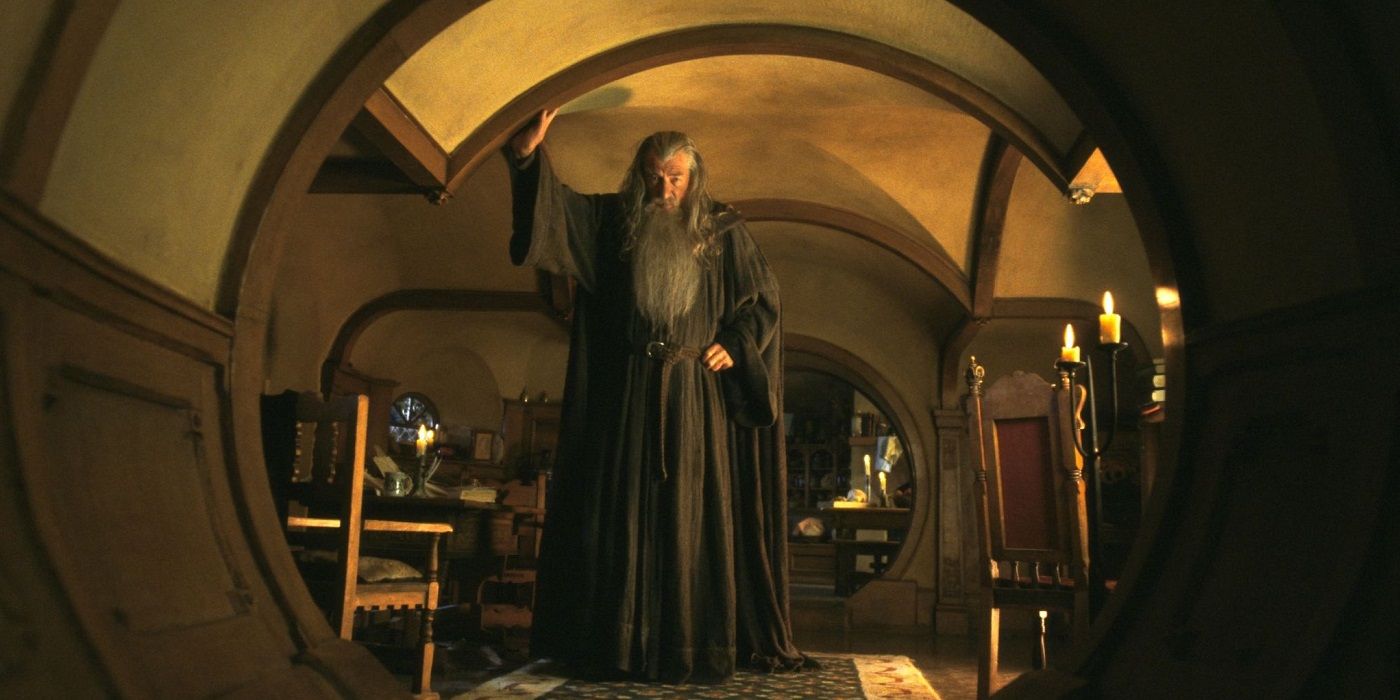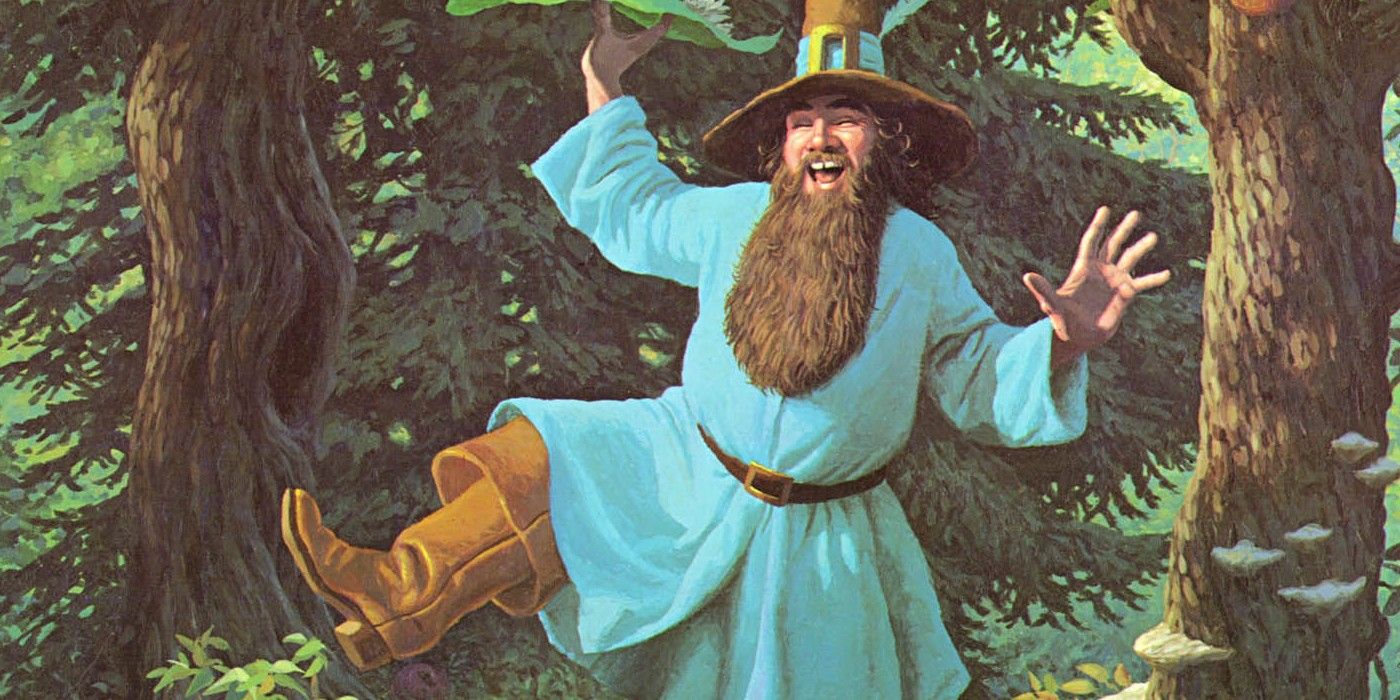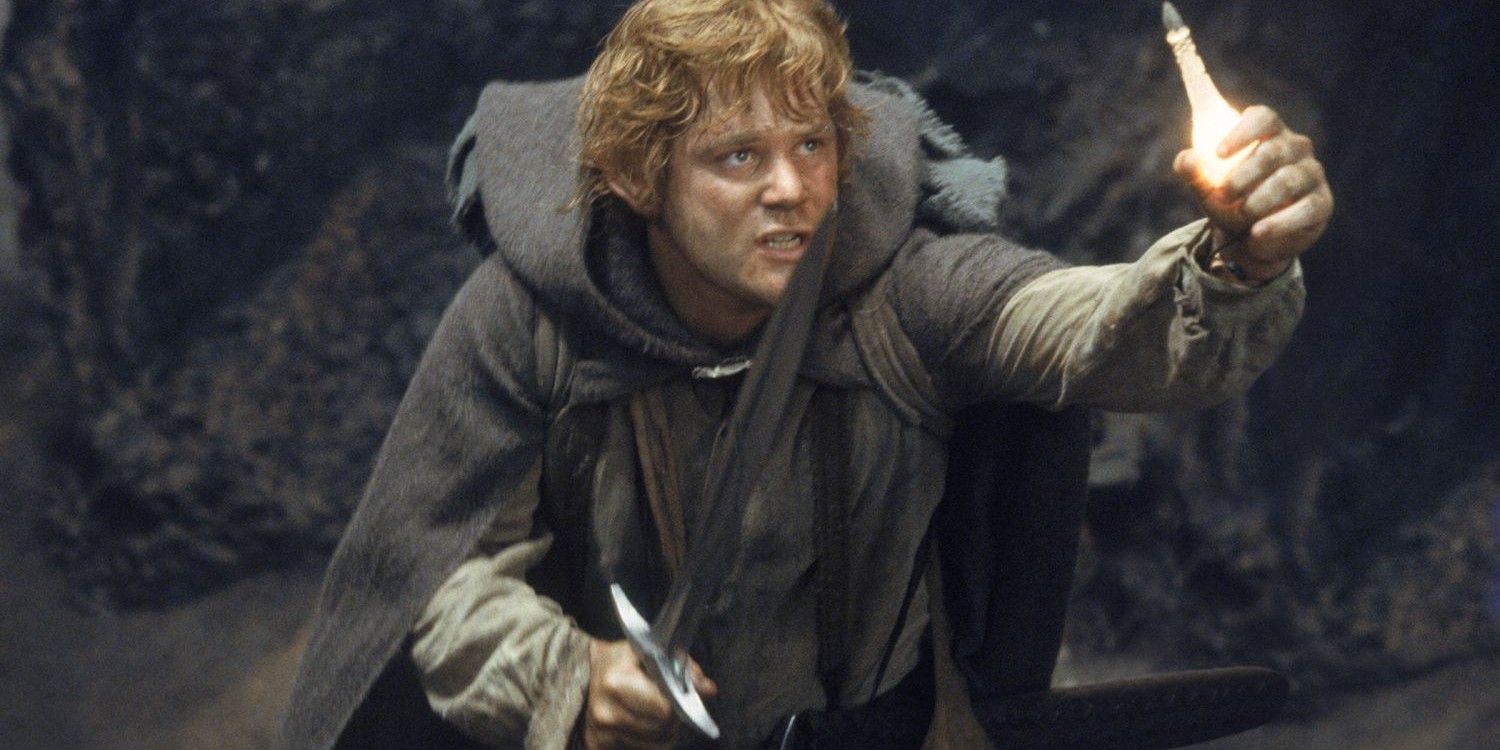Which characters held the infamous One Ring in The Lord of the Rings, and how did they then lose it? In a story where Hobbits save the world, it's perfectly fitting that J.R.R. Tolkien's epic The Lord of the Rings trilogy should revolve entirely around a small, unassuming gold trinket of plain design. The One Ring was created centuries prior to The Fellowship of the Ring in Middle-earth's Second Age, and was imbued with incredible power, dictating the fate of the land and all races living upon it. Tolkien would describe the Ring in almost sentient terms, as if this mystic piece of jewelry had a symbiotic relationship with its owner.
Although the Ring appears ordinary to the naked eye, casting the item into flame reveals the now-famous inscription describing its original purpose. Putting on the Ring sends its wearer partly into the wraith-world, rendering them invisible, but overuse can cause the Ring-bearer to fade into spirit completely, losing their connection to the mortal plane. The One Ring also has a degrading effect on those who hold it for any period of time. Infamously addictive, the Ring makes users hopelessly attached, even without taking advantage of its powers, and lose themselves in the process. The cruel irony of the One Ring is that while the owner's spirit degrades, their life extends, forcing the Ring-bearer to live well beyond their natural years.
Because of the effects described above, the One Ring is desired and feared in equal measure in The Lord of the Rings, and while some are wise enough to avoid it, others fall victim to the Ring's intense lure. The Ring has been the folly of several important figures in Middle-earth, sometimes helping and sometimes hindering. In other eras, the Ring has been forced upon a person who didn't desire its power, but was fated to shoulder its considerable burden. Here are all the Ring-bearers, and how their connection to the treacherous trinket ended.
Sauron
As the creator of the One Ring, Sauron was its original wielder. Following the defeat of Morgoth at the end of the First Age, Sauron gradually recovered his strength and set about continuing his master's work, corrupting and dividing the races of elves and men, who he so hated. Posing as Annatar, Sauron manipulated the elves into crafting Rings of Power, then gifted nine to men and seven to the dwarves. The One Ring was made secretly by Sauron in Mordor, powerful enough control the others, constructed with Sauron's own will contained within. The Dark Lord failed to control the elves and dwarves as intended, but his plan worked perfectly on the men-folk, with each of the nine kings falling under Sauron's sway. Using the power of the One Ring, Sauron became more powerful than ever before, constructed his fortress of Barad-dûr in Mordor, and launched a campaign of terror that threatened to consume Middle-earth.
However, the villain's conquest attracted the ire of Númenor, an island of men separate from Middle-earth. While Sauron eventually managed to corrupt them, the remaining Númenoreans journeyed to Middle-earth and made an allegiance with the elves to topple Mordor once and for all. Faced with the joint might of Elendil, King of Númenor, and Gil-Galad, King of Elves, Sauron was drawn into open combat and after both kings were killed in battle, Elendil's son took the broken sword of his father and sliced the Ring from Sauron's hand. Losing the source of his might massively weakened Sauron and destroyed his physical form. Over 1800 years since its creation, the One Ring had a new owner.
Isildur
As depicted via flashbacks in The Fellowship of the Ring, Isildur took the One Ring from Sauron. The elves knew that the Ring was intrinsically linked to Sauron's power, and as long as it survived, so did the Enemy. They encouraged Isildur to cast the Ring into the fires from whence it came, but the new king fell victim to the same temptation that overcame the Nine and chose to keep Sauron's weapon for his own. Tolkien's unfinished works reveal that after ruling for approximately 18 months with the Ring in his possession, Isildur was persuaded to give up the Ring by his son, and the king embarked on a quest to take the Ring to Rivendell for safe keeping. Attracted by the Ring's darkness, Isildur's party was ambushed by orcs, and as the king tried to flee in the River Anduin, the Ring slipped from his finger into the waters, revealing him to orcs. Isildur died and the Ring lay dormant for over 2000 years.
The story of how Isildur lost the Ring is perhaps an example of Sauron's lingering will at work. Had Isildur relinquished the Ring to Rivendell, the relic's power might've finally been contained. However, the orc attack and the Ring's fall into the Anduin allowed Sauron's life force to live on, and this sequence of events is likely not coincidental. As its creator, Sauron hadn't been negatively affected by the Ring in any unforeseen manner, but the same can't be said for a mortal like Isildur. Holding the Ring for almost 2 years, Isildur was greatly weakened by the time of his death, and like subsequent Ring-bearers, its loss elicited a mixture of both relief and loss.
Déagol
One of several transitional bearers in the Ring's long history, Déagol was the Hobbit unlucky enough to pluck the Ring from the Anduin. Spotting the shining artifact on the riverbed whilst playing with Sméagol, his cousin, Déagol swam down and retrieved the Ring many in Middle-earth thought was lost. Déagol managed a few precious moments handling and admiring the Ring before Sméagol demanded it as a birthday present. Both were enraptured by the Ring's allure and a fight broke out over its ownership. Thus, Déagol's short stint with the Ring ended. Some speculate that the Ring called out to the two Hobbits, choosing to be found after remaining hidden for so many years.
Sméagol/Gollum
Sméagol would become one of the most notable Ring-bearers in The Lord of the Rings history, possessing Sauron's creation for almost 500 years. After stealing the Ring from his cousin, Sméagol's very existence was consumed by his new toy and the Hobbit took to the Misty Mountains to be alone with his "precious." Thanks to the Ring's power, Sméagol lived an unnaturally long existence and became physically deformed - pale, hairless and bent double. During this period of over 400 years, after finding the ring, Sméagol began making a habitual choking sound, and those who were aware of his existence (but didn't know his true identity) named the creature "Gollum" after this violent, unnatural sound. Sméagol's existence was already tragic, but loneliness pushed the creature into insanity, splitting his persona into a kinder half reminiscent of Sméagol the Hobbit, and a darker half that had been fully tarnished by the Ring's power.
Sméagol's loss of the Ring is chronicled in The Hobbit. While adventuring with Thorin's company of Dwarves, Bilbo Baggins found himself lost in the bowels of the Misty Mountains, where he stumbled across and pocketed the Ring without paying much heed to his new find. Although Gollum wouldn't usually leave his Precious lying around, the fallen creature dropped the Ring while fighting a goblin, and by the time he realized it was with Bilbo, the thief had turned invisible and escaped into the distance. Unlike many other Ring-bearers, Gollum never truly left the past behind, pursuing his obsession to the grave and dying alongside it in the fires of Mount Doom. As with Déagol's discovery, it could be said that the Ring chose to leave Gollum behind and be taken by Bilbo, bringing Sauron's power out into the open once more.
Bilbo Baggins
Bilbo Baggins carried the One Ring throughout the rest of his quest, often taking advantage of its magic without realizing the hefty cost involved. Gandalf never entertained that his Hobbit companion might've chanced upon Sauron's infamous Ring, and Bilbo took his prize back to The Shire where both remained for 60 years. During that period, however, the Ring's influence on Bilbo began to tell. Other Hobbits would often remark on Bilbo's youthfulness, not knowing that magic was responsible, and when the Ring eventually found a new owner, Bilbo's face aged considerably before he departed Middle-earth. Although the effects weren't as drastic as they were for Gollum, the Ring's darker traits crept out whenever Bilbo's possession of the trinket was threatened.
Bilbo's time with the Ring came to an end when he decided to leave The Shire for one final adventure. Naturally, the Hobbit's impulse was to take the Ring with him, but Gandalf had finally started to suspect something was amiss and used the full extent of his magical presence to force Bilbo into leaving the Ring behind, albeit with no small amount of reluctance. Although Bilbo was noticeably lightened after this, the Ring's hold over him never quite abated, so he always showed a keen interest whenever he had the chance to see his golden friend one last time.
Frodo Baggins
After Bilbo's departure, Frodo became the next Ring-bearer by inheritance. Although he departs almost straight away in Peter Jackson's movie trilogy, Frodo keeps the Ring harmlessly tucked away for a full 17 years in Tolkien's original books - the Ring-bearer in name only. It was only when Sauron made his move and Gandalf revealed to Frodo the true importance of his cousin's treasure did Frodo start carrying the Ring proper, first to Rivendell, and then all the way to Mordor. Excluding the 17 years spent dwelling in The Shire, Frodo held the Ring for another six months, keeping it close at all times on his road to Mount Doom, and the burden certainly took its toll. Frodo showed the early signs of obsession that plagued Gollum and Bilbo before him, and the Ring had a wearying effect on its final owner. Frodo lost or relinquished the Ring on several occasions during his journey, but as the official Ring-bearer, always returned to his task.
As fated, Frodo's tenure in possession of the Ring came to an end at Mount Doom. With the Ring's destruction imminent, its hold upon Frodo tightened, and the Hobbit briefly made the same mistake Isildur had thousands of years prior, refusing to do the right thing. Although Frodo couldn't complete his mission, destiny had other ideas and a scrap between Frodo and Gollum ended with Sméagol falling into the flames, taking the Ring with him. As with his predecessors, Frodo immediately felt unburdened after the Ring's destruction, but never made a full recovery, and ultimately left Middle-earth behind.
Gandalf
Gandalf was never an official Ring-bearer. Even as Maia, Gandalf feared the influence of the One Ring, and had he been corrupted, Middle-earth would've been in even deeper trouble. Nevertheless, the wizard did handle the Ring for a brief time while confirming his suspicions, tossing it into the fireplace of Bag End to check if Sauron's sinister inscription would appear. Evidently, Gandalf was confident enough in his own power to resist the Ring for a few seconds. Interestingly, Gandalf never directly touches the Ring in the Fellowship of the Ring movie. Instead, he touches the envelope containing the Ring, then uses tongs to remove it from the flames and place it directly into Frodo's hand. In the original books, however, it is Frodo who puts the ring in the envelope and Gandalf does touch the ring, at least twice in the process of examining it.
Tom Bombadil
Another temporary Ring-bearer in Tolkien's The Lord of the Rings trilogy is the mysterious Tom Bombadil, although he holds onto the item longer than Gandalf. In The Fellowship of the Ring, Frodo and his Hobbit companions find themselves the guests of Tom Bombadil before meeting Aragorn. Frodo openly tells Tom about his quest and even lets him play with the Ring. Much to Frodo's surprise, the Ring means nothing to Bombadil. There's no enticement on Tom's part, no power or gravity, and Frodo's enigmatic host even puts the Ring on without disappearing, happily handing it back without a struggle. Tolkien never reveals the true nature of Tom Bombadil in The Lord of the Rings, so it's impossible to say exactly how he resists the Ring so effortlessly, but the working theory is that Tom possessed full mastery of his forest realm, meaning that as long as the Ring remained within his borders, it was no more threatening than a regular piece of jewelry.
Samwise Gamgee
The final of the three temporary Ring-bearers during Frodo's reign is his closest friend, Samwise Gamgee, who has a far more in-depth Ring experience than Gandalf or Tom Bombadil. The humble Samwise does remarkably well to resist the power of the Ring while travelling with Frodo, but is forced to carry the burden when the official Ring-bearer of the Fellowship is incapacitated by Shelob and taken by orcs. Even during his short time possessing the Ring, Sam continues to brush off its influence, and after Frodo is rescued, is happy to hand it back without a fuss. Throughout The Lord of the Rings, only Tom Bombadil is more successful in denying the Ring's will, which perfectly demonstrates Sam's unerring inner strength.

